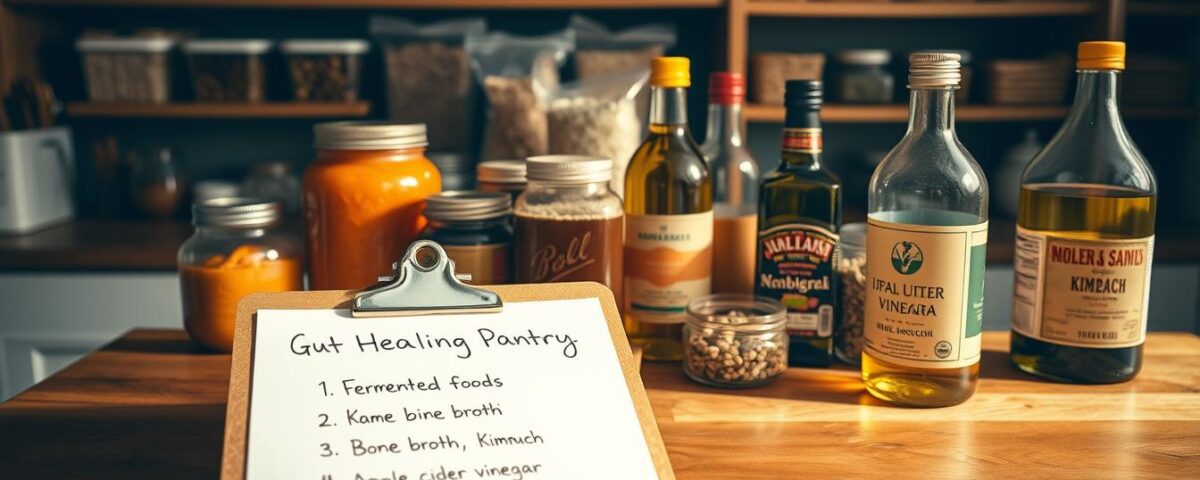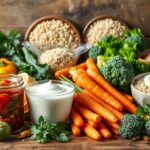
Best Foods for IBS Relief According to Nutrition Experts
May 24, 2025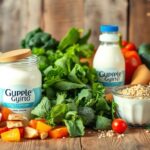
Top 6 Ingredients to Always Have on Hand for Digestive Health
May 24, 2025Did you know 70% of your immune system resides in your digestive system? That’s right—the choices you make in your kitchen can directly influence how you feel every single day. For years, I struggled with bloating and fatigue until I realized my pantry wasn’t just a storage space—it could be a wellness powerhouse.
Like many people, I used to grab whatever was convenient. But after overhauling my approach, I discovered how simple swaps—like adding prebiotic-rich oats or fermented foods—could transform my energy and digestion. It’s not about perfection; it’s about intentionality. Every jar, spice, or grain becomes a tool to nourish your body.
What makes this work? Science-backed pairings. For example, combining fiber-packed lentils with turmeric boosts anti-inflammatory benefits. Or pairing chia seeds with berries creates a microbiome-friendly snack. These aren’t just recipes—they’re strategies for long-term wellness.
Key Takeaways
- Your pantry’s organization impacts digestive health more than you might expect.
- Strategic ingredient pairings maximize nutritional benefits.
- Small changes, like adding fermented foods, yield noticeable results.
- Focus on nutrient-dense staples rather than restrictive diets.
- A well-planned setup simplifies daily meal decisions.
Introduction: My Journey to a Healthier Gut
Years of unexplained fatigue led me to rethink my kitchen choices. I’d wake up feeling sluggish, despite eating what I thought were “healthy” meals. A nutritionist friend pointed out that my digestive system might be struggling due to poor food combinations and processed ingredients.
Why I Embraced a Gut-Healing Lifestyle
Everything changed after I learned how tiny organisms in our bodies impact overall health. Research showed that certain foods could either feed harmful bacteria or support beneficial ones. I started swapping sugary snacks for fermented items like kimchi and kefir. Within weeks, my energy levels improved dramatically.
How My Pantry Became the Starting Point
Clearing out old boxes of crackers and instant noodles was step one. I filled shelves with colorful jars of lentils, quinoa, and spices like ginger. This shift made meal prep simpler and aligned with my new diet goals. Now, every ingredient serves a purpose—whether it’s reducing inflammation or boosting fiber intake.
Small changes created big results. For example, adding flaxseeds to smoothies helped balance my microbiome. Even my morning coffee got an upgrade with cinnamon for its anti-inflammatory perks. It’s amazing how intentional food choices can rewrite your relationship with eating.
Building My “Gut Healing Pantry Checklist”
Transforming my kitchen storage into a wellness hub began with three questions: What fuels my body best? What saves time? And what actually tastes good? The answers shaped a practical system that works even on hectic days.
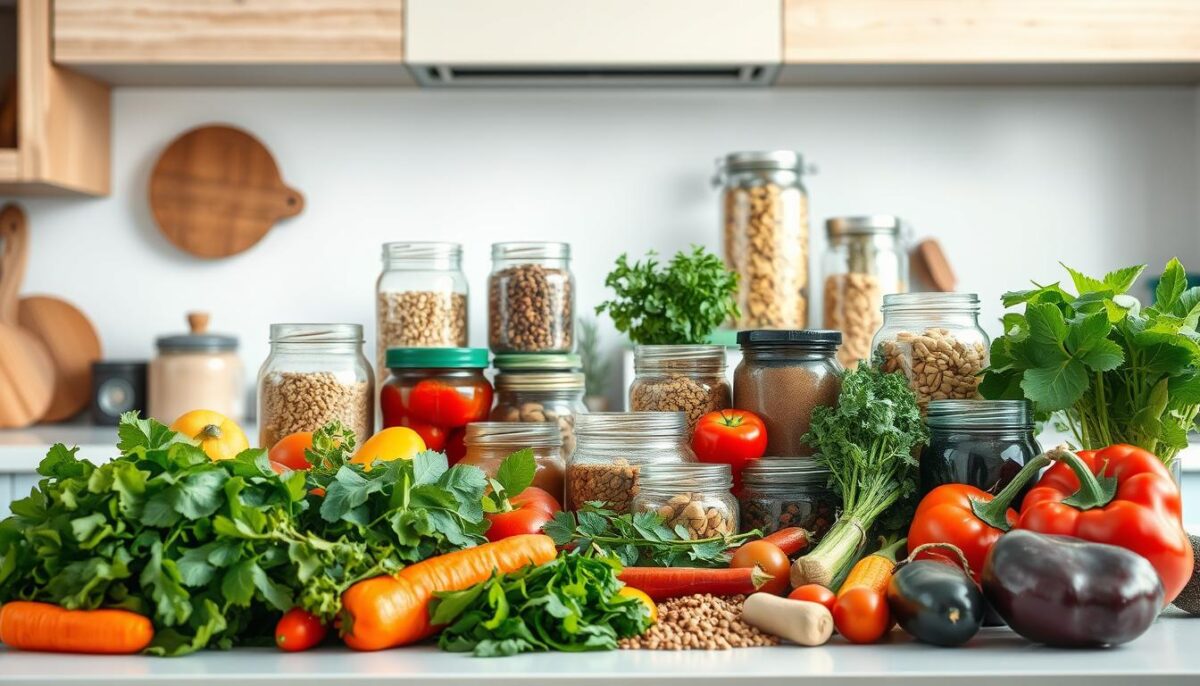
Key Nutrient Boosters to Stock
I prioritize protein sources that multitask. Organic chicken, canned wild salmon, and lentils cook quickly while supporting muscle repair. For grains, I stick with quinoa and oats—they’re packed with fiber and adapt to sweet or savory dishes.
One game-changer? Bone broth. I keep FOND’s collagen-rich version on hand for sipping or boosting soups. Its amino acids help seal the gut lining, according to a 2022 Nutrition Journal study. Paired with turmeric, it becomes an anti-inflammatory powerhouse.
Don’t underestimate oil choices. Olive oil dresses salads, while avocado oil handles high-heat cooking. Both contain fats that reduce inflammation better than processed alternatives.
Tools and Tips for Easy Organization
Clear glass containers revolutionized my space. Seeing ingredients prevents forgotten items and inspires creativity. I group items by use:
| Zone | Items | Benefit |
|---|---|---|
| Quick Meals | Canned beans, broth | 5-minute soups |
| Snack Attack | Nuts, roasted chickpeas | Portable protein |
| Flavor Boost | Spices, oils | Enhance any dish |
Weekly shelf checks keep staples like grains and protein sources replenished. Labeling containers with expiration dates cuts waste. Now, even my teen can assemble balanced meals without asking “What’s for dinner?”
Pantry Staples and Essential Foods
What we keep on our shelves shapes how we fuel our bodies daily. After years of trial and error, I’ve found that focusing on quality over quantity creates lasting changes. The right combinations of fats, nutrients, and natural flavors make every meal an opportunity to nourish.
Healthy Fats, Oils, and Broths
Not all fats are created equal. I prioritize unrefined options like extra-virgin olive oil for dressings and coconut milk for curries. These deliver immune-supporting fatty acids that processed oils lack. A 2021 study in Nutrients journal found that diets rich in healthy fats improve nutrient absorption by 40%.
Broths became my secret weapon. Homemade bone broth simmers collagen into liquid gold, but store-bought versions work too. I pair them with turmeric or ginger for extra anti-inflammatory power. For quick meals, I’ll sauté veggies in coconut oil—its high smoke point prevents harmful oxidation.
Fruits like blueberries and figs add natural sweetness while packing antioxidants. I keep frozen varieties handy for smoothies or oatmeal toppings. When choosing packaged items, I scan labels for minimal ingredients—no hidden sugars or artificial additives.
Organization is key. Oils go in a dark corner to prevent spoilage, while broths stack neatly in labeled bins. This setup lets me grab what I need without second-guessing—because consistency matters more than perfection.
Simple Meal Ideas from My Pantry
Turning basic ingredients into satisfying meals became my superpower. With a few core items, I create dishes that taste great and support my body. Here’s how I balance flavor, speed, and nutrition without stress.
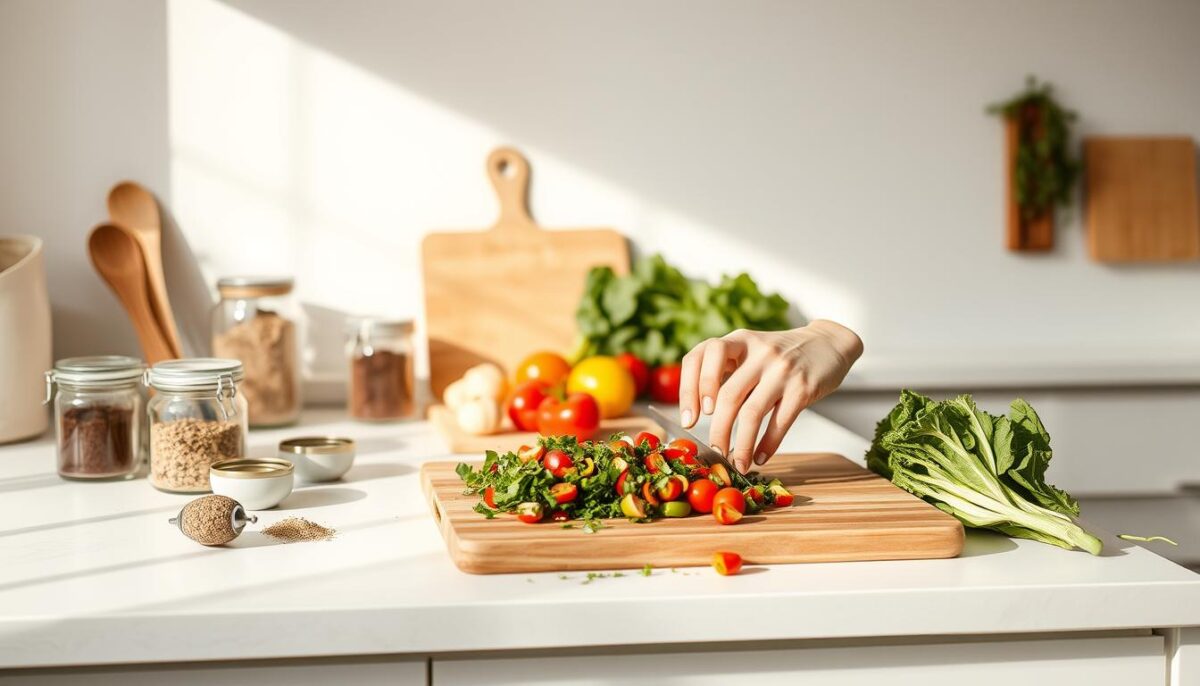
DIY Recipes for Healing Meals
My go-to breakfast? Turmeric scrambled eggs with spinach. It takes 5 minutes and combines anti-inflammatory spices with protein. For lunch, I’ll toss canned salmon with quinoa and roasted veggies—a fiber-rich combo that keeps me full for hours.
| Meal | Key Ingredients | Benefits |
|---|---|---|
| Power Bowl | Chicken, kale, sweet potato | Balanced protein + vitamins |
| Fish Tacos | Cod, cabbage slaw, avocado | Omega-3s + healthy fats |
| Lentil Soup | Broth, carrots, ginger | Gut-friendly fiber |
Mix-and-Match Ingredient Combinations
I build meals around proteins like chicken or fish, then add veggies and grains. Try these swaps:
- Grilled salmon + zucchini noodles + pesto
- Shredded chicken + brown rice + broccoli
- Boiled eggs + mixed greens + olive oil drizzle
Quick Snacks and On-the-Go Protein Options
When time’s tight, I grab spiced nuts or apple slices with almond butter. Pre-cooked chicken strips or smoked fish packets are lifesavers during errands. My secret? Keep hard-boiled eggs in the fridge—they’re ready when hunger strikes.
Pro Tips for a Sustainable Gut-Healing Pantry
Keeping my kitchen stocked for long-term wellness taught me smarter isn’t always better—it’s about intentional choices. Focus on systems that simplify decisions while supporting your whole-body health. Here’s how I balance practicality with science-backed nutrition.
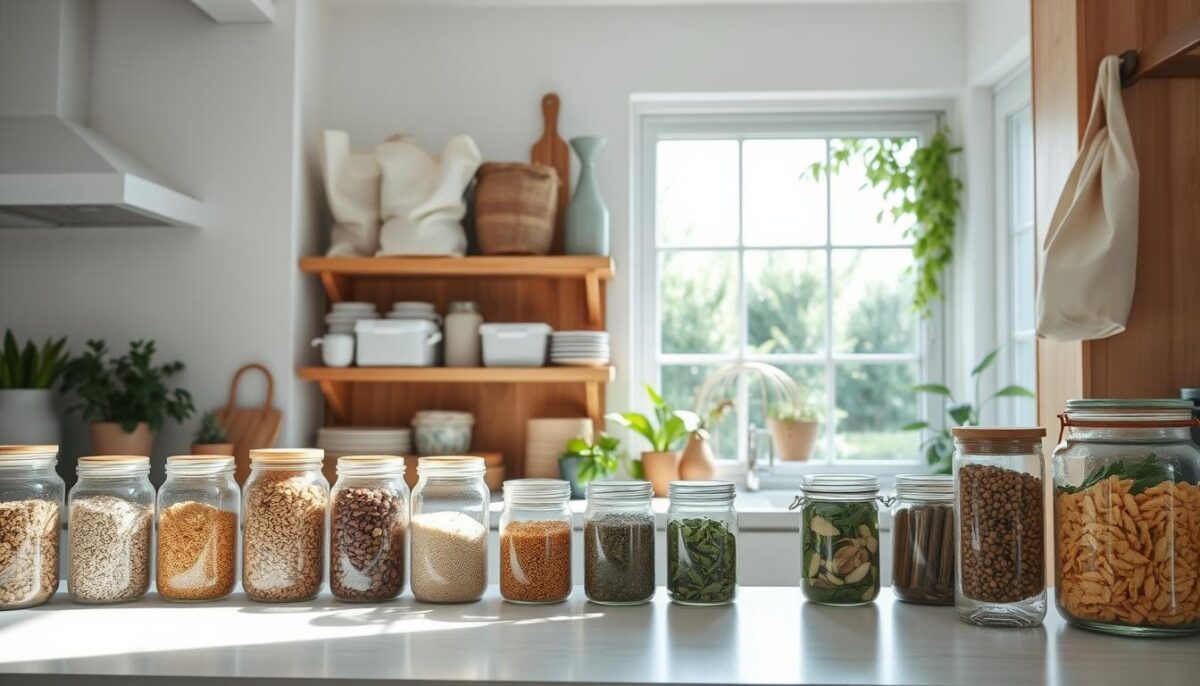
Smart Shopping and Storage Strategies
I start at the store by reading labels like a detective. If an ingredient list sounds like a chemistry experiment, it probably won’t support a healthy gut. I prioritize fermented products like sauerkraut—their live cultures feed good bacteria naturally.
Storage matters as much as selection. Olive oil gets a dark cabinet spot to prevent rancidity, preserving its heart-healthy polyphenols. Bulk bins became my friend for nuts and seeds—they’re cheaper and let me buy only what I need. I use clear jars to spot expiration dates quickly.
Adapting My Pantry for Seasonal Changes
Summer means stocking fresh herbs and lighter broths, while winter calls for squash and warming spices. I rotate products every 3 months to match my body’s shifting needs. Frozen berries in January keep smoothies antioxidant-rich without spoilage stress.
Glass containers with airtight seals protect against humidity and pests. I keep a “use first” shelf for items nearing expiration. This approach cuts waste by 30% while keeping meals exciting—a win for my healthy gut and wallet!
Conclusion
Revamping my kitchen staples transformed more than just meals—it reshaped my daily energy and well-being. By focusing on whole food foundations like beans, seeds, and quality oils, I built a system that supports my body without complicated rules. Small shifts—swapping processed snacks for roasted chickpeas or adding bone broth to soups—created lasting changes.
Simple pairings make the biggest difference. Olive oil drizzled over steamed veggies boosts nutrient absorption. Chia seeds mixed into oatmeal add fiber for better digestion. These choices aren’t drastic, but their cumulative effect surprised me. Within weeks, I noticed less bloating and steadier energy.
Your journey starts with what’s already on your shelves. Audit expired items, then restock with versatile basics. Track how your body responds—maybe turmeric becomes your go-to spice or lentils your new protein staple. Progress, not perfection, builds sustainable habits.
Every meal is a chance to nourish yourself. With intentional ingredients and a dash of curiosity, you’ll craft a kitchen that works for you—one delicious bite at a time.
FAQ
What’s the easiest way to start improving gut health through my pantry?
I began by swapping processed items for whole foods like fermented veggies (sauerkraut, kimchi), bone broth, and olive oil. These support digestion and reduce inflammation. Stocking up on fiber-rich lentils, quinoa, and chia seeds also made meals both nourishing and simple.
Are there specific oils or fats I should prioritize?
Absolutely! I rely on extra-virgin olive oil for salads, coconut oil for cooking, and ghee for its buttery flavor without dairy irritants. These healthy fats reduce gut inflammation and help absorb fat-soluble vitamins like A and D.
How do I keep my pantry organized for gut-friendly meals?
I use clear jars for staples like almonds, pumpkin seeds, and dried herbs. Labeling shelves by category (e.g., proteins, grains, spices) saves time. Prepping mason jars with overnight oats or chia pudding also makes mornings stress-free.
Can I still enjoy snacks while healing my gut?
Yes! I keep roasted seaweed, unsweetened coconut flakes, and dark chocolate (70%+) on hand. Pairing apple slices with almond butter or hard-boiled eggs with avocado also keeps cravings in check while fueling good bacteria.
What’s a budget-friendly protein source for gut health?
Canned wild-caught salmon and sardines are my go-tos—they’re rich in omega-3s and cheaper than fresh fish. Lentils and black beans are also affordable, fiber-packed options that work in soups, salads, or tacos.
How do seasonal changes affect my pantry choices?
In summer, I stock fresh basil, zucchini, and berries for lighter meals. During winter, I focus on warming spices like turmeric and cinnamon, plus shelf-stable squash and bone broth for cozy soups. Rotating items keeps meals exciting and nutrient-dense.
Are there any spices that specifically support gut health?
Ginger and turmeric are my top picks—they’re anti-inflammatory and aid digestion. I add them to teas, smoothies, or roasted veggies. Cumin and fennel seeds also help reduce bloating, so I sprinkle them on roasted chickpeas or salads.
